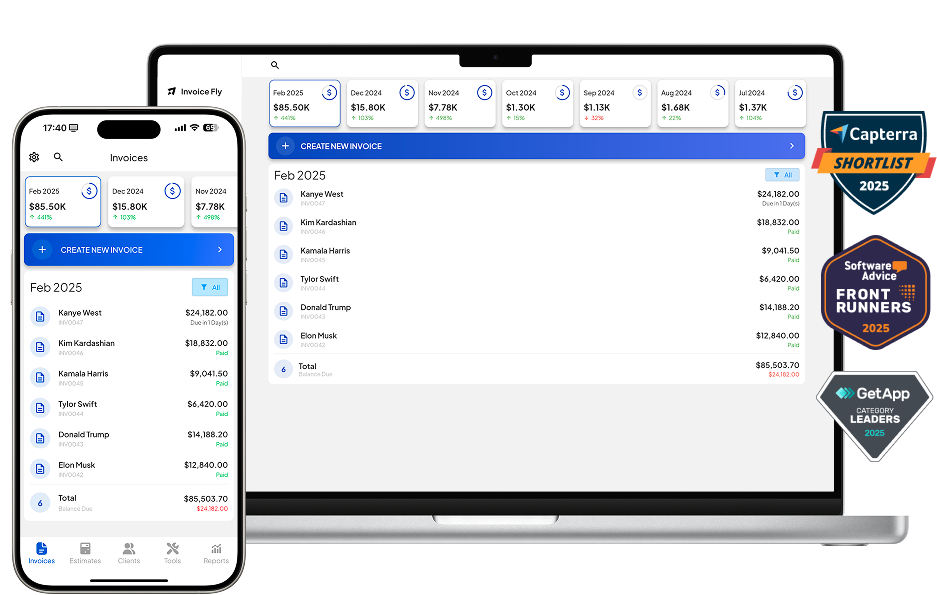- Home
- »
- Free Resources for Small Businesses
- »
- Free Business Calculators
- »
- Service Price Calculator
Service Price Calculator
Use Invoice Fly service price calculator to add up all the costs that go into a job estimate, including your labor costs, material costs, overhead expenses, and profit. Get an accurate and profitable price for your services, then add your pricing to our free estimate template.
Service Price Calculator
Number of workers needed for the job
Total hours required to complete the job
Average hourly rate per worker
Total monthly business expenses (rent, utilities, insurance, etc.)
Total working hours per month
Total hours needed to complete this specific job
Total cost of all supplies used for the job
Net amount your business gets to keep after costs and expenses

Total Summary
What Is A Service Price Calculator?
A Service Price Calculator is a business tool designed to calculate the cost a service business should charge their customers. Our calculator factors in various elements such as labor costs, materials, overhead, and desired profit margins to determine the final pricing of a service.
Invoice Fly’s free service price calculator helps field service businesses (landscaping, lawn care, tree care, snow removal, etc.) ensure transparency in pricing, aids in financial planning, and enhances customer satisfaction by providing clear and tailored service cost estimates.
How to use the service price calculator
Follow our step-by-step guide to create profitable pricing using Invoice Fly’s free service price calculator:
- Enter your labor costs: Add the total labor costs, or use the “Calculate Labor Costs” drop-down to enter the number of workers, hours, and average hourly pay.
- Enter your material costs: Total the cost of all supplies required to complete the job.
- Add your overhead costs: Enter the total overhead costs for the job, or click “Calculate Overhead Expenses” and enter your monthly expenses amount, working hours each month, and how many hours it will take to complete the job.
- Add your profit: Enter the net dollar amount you’d like to keep after deducting labor, materials, and overhead.
- Review your pricing: Check your service price, profit, and markup on the right-hand side of the calculator. Adjust any costs or your profit to make sure your price is competitive and profitable.
How to calculate a service price
You can use the calculator above to calculate profitable service pricing, or follow these steps to do it yourself:
- Determine your labor costs: Multiply the number of hours you’ll need to complete the job by your hourly rate. Make sure to take into account wages, taxes, workers’ compensation, and other employee-related expenses.
- Add your material costs: Total the amount you’ll spend on materials, supplies, or parts required to complete the job.
Factor in your overhead costs. Determine your hourly overhead cost rate and multiply that by the number of hours you expect the job to take. - Add your desired profit margin to get the final cost you’ll charge your customer.
- Before sending the service price to your customer, check out what your competitors would charge for the same service. This will help you determine if you’re offering a competitive rate or if you’re pricing yourself out of the market.
What Are Labor Costs?
Hourly wages or salaries.
Payroll taxes: Social Security, Medicare or others.
Workers’ compensation insurance.
Health benefits.
Paid time off: vacation, sick days, holidays.
Training costs.
What Are Material Costs?
Raw materials: wood, cement, mulch, paint, parts, etc.
Consumables: nails, glue, tape, fuel used on-site, etc.
Purchased items for the client’s job: replacement parts, fixtures.
Delivery or shipping costs for materials.
What Are Overhead Costs?
Overhead Costs are the indirect expenses required to run your business—costs that aren’t tied to a specific job, but are necessary to keep your business operating.
These costs don’t go away even if you don’t have a project this week—they’re part of your everyday business operations. They tipically include:
Office or shop rent.
Utilities (electricity, internet, phone).
Business insurance.
Equipment maintenance or depreciation.
Vehicles and fuel (not job-specific trips).
Software and subscriptions.
Marketing and advertising.
Licenses, permits, or certifications.
Admin or accounting services.
Service price formula
Use this service price formula to determine how much you should charge for a service to cover your costs and make a profit:
Simple version:
Service Price = (Labor Costs + Material Costs + Overhead Costs) + Desired Profit
Advanced version:
SP = (MC+L)/(1 – DM)/100)
Where:
- SP is the Service Price
- MC is the Material Costs
- L is de Labor Costs
- DM is de Desired Profit.
Or, skip the manual calculations and use our service price calculator above.
Example 1: 🛠️ Handyman Business
Scenario: Repairing doors and fixing trim.
- Hourly costs & expenses:
- Labor + taxes + insurance = $30/h
- Overhead (transport, tools, office) = $15/h
- Desired profit margin: 25%
- Estimated job time: 3 hours
Calculation:
- Cost basis per hour: $30 (direct costs) + $15 (overhead) = $45/h
- Markup for profit: $45 × 1.25 = $56.25/h
- Total job price: $56.25 × 3 h = $168.75
🧾 Handyman charge: $169 for the 3-hour job.
Example 2: 🌿 Landscaping Business
Scenario: Lawn mowing and edging for a medium-sized suburban yard.
- Hourly costs:
- Wage + insurance = $20/h
- Equipment/transport = $10/h
- Desired profit margin: 30%
- Estimated job time: 5 hours
Calculation:
- Base cost per hour: $20 + $10 = $30/h
- After markup: $30 × 1.30 = $39/h
- Total for 5 hours: $39 × 5 = $195
🌱 Landscaping job priced at $195.
Example 3: 💦 Pressure Washing Business
Scenario: Cleaning a driveway and patio.
- Hourly costs:
- Labor + PPE etc. = $25/h
- Equipment depreciation, water, fuel = $15/h
- Desired profit margin: 20%
- Estimated duration: 2.5 hours
Calculation:
- Base cost per hour: $25 + $15 = $40/h
- Price after margin: $40 × 1.20 = $48/h
- Total job cost: $48 × 2.5 = $120
🚿 Pressure washing job priced at $120.
FAQs about our Online Service Price Calculator
This service price calculator helps you price jobs for profit, factoring in labor, materials, and overhead expenses. You can use this pricing as a quick reference point for estimating jobs, or as a standard price for recurring services.
Pricing calculators are perfect for entrepreneurs who are just getting started, or established business owners who are tired of doing calculations with pen and paper. Try this fast and easy way to price your services—without having to do the math yourself.
Our service price calculator is just one of our free tools, which help you store client information, convert estimates to invoices, and get paid for your work. This calculator is an essential tool for any pricing strategy. Bookmark this page and use it for free whenever you’re pricing your services.
To make sure your service prices are accurate and profitable, avoid these common mistakes:
- Underestimating labor time or costs. Make sure to factor in time for setup, cleanup, and travel.
- Forgetting indirect or overhead costs. Don’t skip costs like fuel, insurance, marketing, or field service software.
- Not including enough profit. Make sure you hit your desired profit margin to avoid working for free.
- Using outdated costs. Regularly update your labor, material, and overhead costs to ensure accuracy.
- Not reviewing competitor pricing. Compare your final price with local market rates to stay competitive and profitable.
How much you charge for your services will depend on your labor costs, material costs, overhead costs, and desired profit margin.
Compare your pricing to local competitors to stay competitive while highlighting the value of your services.
Keep your rates up to date by reviewing them regularly and adjusting for changes in costs, demand, and market trends.
Knowing how to calculate the cost of service is as simple as using this pricing formula for services:
Labor cost + Material cost + Overhead expenses + Desired profit.
To calculate your labor, figure out how many workers the job will need, how many hours it’ll take them to finish the work, and how much they’re paid per hour. Then multiply all three using this formula:
Number of job employees x Hours to complete the job x Hourly pay
Let’s say you’re pricing a recurring weekly service. You’ll need two people on site for four hours to provide that service, and they both make $18/hour. That means the labor costs for each weekly job will be $144. (2 x 4 x 18 = 144)
(You can also use our free labor cost calculator to determine what your hourly rate should be.)
List the materials and supplies you’ll need to use for that specific job. There are two ways to do that, depending on whether you’re using full or partial quantities of your materials:
- If you’re special-ordering materials or using the entire quantity of what you have, add up your supplier’s listed prices for those items.
- In some cases, you’ll only use part of a particular material—for example, half a container of cleaning solution. Just estimate how many jobs you can get out of one container, then divide the cost of the item by the number of jobs. This tells you how much you should charge for that material per job.
Keep in mind that you’re buying these items yourself, which takes time, effort, and gas money. Feel free to add a small markup percentage to your material costs to take back some of those expenses.
Add up all the costs you pay each month to keep your business up and running. This could include building rent, business insurance, advertising costs, cell phone or data plans, or invoicing software like Invoice Fly.
If you have any annual costs like commercial vehicle registration, add up these yearly expenses and divide by 12 to get a monthly total.
Once you have your total monthly overhead costs, divide that amount by the number of workable hours each month. This will tell you what your hourly expenses are—and what to charge clients for overhead per job.
Here’s the full formula:
(All monthly expenses / Working hours each month) x Hours to complete job
Need help tracking your business expenses? Try Invoice Fly's Receipt Scanner to track all business expenses.
Profit should usually make up 10–20% of your job costs. You may have to adjust your profit amount in the calculator to reach a profit margin that works for you—without having your customers say your price is too high.
Talk to other business owners in your industry and see how much profit they’re earning on each job. You don’t have to match them, but if you know a business operates similarly to you and profits more, you might have room to increase your prices.
You can also use our profit margin calculator to make sure you’re profiting from every job.
Your markup is the extra money you charge for your services, over and above your costs and expenses, in order to turn a profit as a business. For example, let’s say your labor, materials, and overhead for a job are $250, and you add a $50 markup. You’re marking up the job’s value by 20%, bringing the total value to $300.
Your profit margin is how much money your business gets to keep after you’ve subtracted all business expenses from the total payment amount. If your final job pricing was $300, the $50 you’re keeping as profit would give you a profit margin of 16.67%.
Both your markup and profit margin can be represented as a percentage or dollar amount.
A service price calculator helps you price a service based on your costs, expenses, and desired margin. Here’s how a service pricing calculator can help you:
- Easily add up all the costs that go into an estimate
- Take less time to price a job
- Prevent errors that affect your bottom line
- Always remember to include your costs and expenses
- Double-check your profit margin and markup percentages
With a service rate calculator, it takes only seconds to add up the numbers you need, add them to an estimate, and send your estimate to the client—winning you profitable work.
When you’re done using our job estimate calculator, use our free estimate template to create a service estimate for your clients.
You can also upload your pricing into job estimating software like Invoice Fly. This makes it easy to make a professional estimate using your desktop or mobile app.
Here’s what you can do with Invoice Fly:
- Create professional estimates in seconds.
- Request deposits and online signatures to ensure client's commitment.
- Easily convert estimates into invoices in 1 click.
- Store information about clients and job items like predefined services, maintenance packages, hourly prices and more.
- Get paid faster with automated invoice follow-ups and credit card or ACH payment processing
Learn more about how Invoice Fly can help you create estimates and win work faster.
Other Free Calculators

Try Invoice Fly Today
- Send quotes & invoices in seconds
- Collect card & online payments
- Receive instant notifications
- Win more jobs




